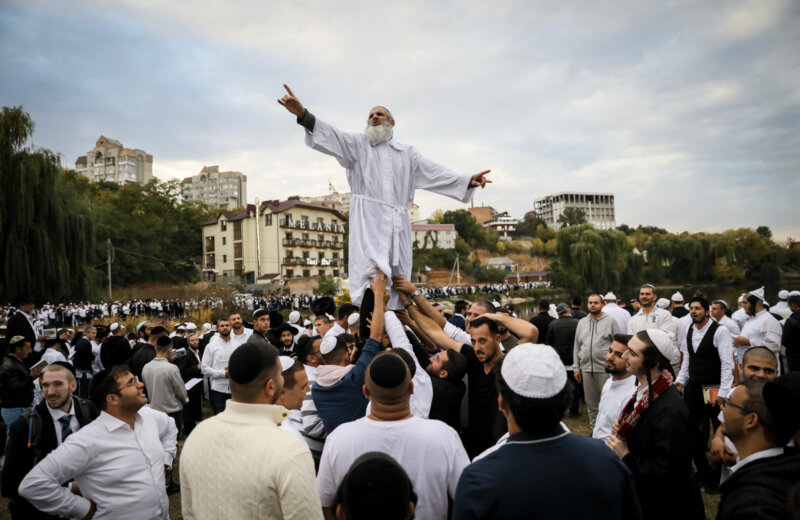UMAN, Ukraine – In 1776, Polish Count Staniwslaw Potocki commissioned the construction of a garden in the then-Polish owned town of Uman, what is now central Ukraine. The splendid park with artificial waterfalls and grottoes decorated with statues of Greek gods was a gift to his future wife Zofia. Born to Greek parents in the Ottoman Empire, Zofia is known in European history as a courtesan whose beauty and numerous love affairs with powerful men brought her fame, wealth, and noble status.
Uman was under the Potocki rule when Rabbi Nachman, the founder of the Breslov offshoot of Hasidism, moved to the town in 1810 and spent the last five months of his life there.
Today, Sofiyivsky Park and Rabbi Nachman’s gravesite are the main visitor attractions in Uman, a town of 82,950 people located some 200 kilometers from Kyiv.
Tens of thousands of pilgrims flock to the Ukrainian town annually to visit the grave of Rabbi Nachman of Bratslav to celebrate the Jewish New Year, Rosh Hashanah. For a few days, a sleepy town is captured by Hasidic revelry.
This year, nearly 27,000 Hasidic Jews arrived in Uman to mark year 5780, starting at sundown on Sept. 29, according to the Jewish calendar. Praying on Rabbi Nachman’s tomb is believed to expiate one’s sins and bring great blessings in the new year.
Pushkin Street
During Soviet times, Jewish pilgrims could not get visas to attend the holy site. Since Ukraine gained independence, the pilgrimage to Uman has been growing. As a result, the neighborhood surrounding Rabbi Nachman’s grave and the old Jewish cemetery has undergone a transformation over the last two decades.
Shop signs and banners on buildings on Pushkin Street, which leads to the tomb and a synagogue, are in Hebrew. Kosher restaurants, stores, and hotels have popped up to cater for pilgrims and the small Orthodox Jewish community of Uman. Over the last few years, several dozen Hasidic families moved here.
One of the largest banners reads “Uman Loves Trump” with lines in Hebrew from Talmud “We are thankful for what you have done for us” and “We are sated with your kindness,”— phrases usually reserved for God.
Most pilgrims come to Uman from Israel and the United States, and many have supported U.S. President Donald Trump’s controversial decision to move the U.S. Embassy in Israel from Tel Aviv to Jerusalem.
Two hundred meters away from Rabbi Nachman’s burial site stands hotel Melania, but it is unclear whether its owner was inspired by Melania Trump.
Festivities
But Uman wasn’t always so accommodating to pilgrims.
Adi from Jerusalem has been coming to Uman for 20 years. He said the infrastructure of the town has improved but the prices went up drastically too.
“Twenty years ago, there were only old houses. We paid $5 a night. Today you get a bed (in a shared room) for $200 a night. It has become very expensive. Flights around the year are cheap but on Rosh Hashanah they cost as if you’re going to New York,” he said.
Although local residents have complained about noise and garbage that visitors leave behind, for many it is a way to earn an extra buck. Owners of apartments and houses located near the holy area rent their homes out for a few days.
Gershon, who grew up in New York but now lives in Jerusalem, said such a transactional relationship with locals did not offend him.
“It is all about money. They don’t really care for us. I do think it is business. We come with money. But it’s not bad. The whole world in business,” he said.
Rosh Hashanah lasts for 48 hours. In the morning, pilgrims pray and read Torah to the sound of shofar, a ram’s horn, and clapping. In the evening of the first day, they gather near a small lake for the soul-cleansing ceremony of Tashlich. The celebration continues with singing and dancing in the streets until nightfall.
“Rabbi Nachman’s message was always be happy, never despair, and believe in yourself, even when things are getting difficult, be your true self,” said Gershon.
Nachman’s brand of Hasidism is mixed with Jewish mysticism and preaches a joyous, individualistic approach to spirituality.
It is not rare to see pilgrims drinking beers and smoking cannabis.
The rules appear to be loose. It is forbidden to drive and use any tech devices on holiday, including appearing on TV cameras.
But there is no strict dress code. Some wear side-curls and sport traditional costumes and hats. Others are dressed in casual clothes.
During Rosh Hashanah, the area is guarded by Ukrainian and Israeli police. The non-Jewish residents, and especially women, have to prove they live or work there.
This year’s festivities went calmly. But in the past, police said there were incidents of violence among the locals and pilgrims, involving stabbings, knife fights, a grenade explosion, and attacks on women.
Women do not partake in pilgrimage, and few female journalists are allowed into the area and cannot enter the synagogue nor approach the Rabbi Nachman’s tomb.
Some pilgrims stay in Uman for Yom Kippur, a holiday observed on the 10th day after Rosh Hashanah.



